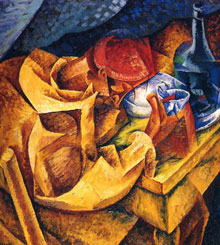 Romaine Brooks was another wonderful artist that challenged the still present male gaze in the patriarchal society we live in. She went against the socially acceptable pretty dress and well-kept hair and makeup and dressed like she felt best. In her Self Portrait made in 1923, she appears looking more like a man than a woman and it became a big controversy.
Romaine Brooks was another wonderful artist that challenged the still present male gaze in the patriarchal society we live in. She went against the socially acceptable pretty dress and well-kept hair and makeup and dressed like she felt best. In her Self Portrait made in 1923, she appears looking more like a man than a woman and it became a big controversy.
Modernism was the period in which artists disregarded previous art styles and techniques and began to explore what had never been done before as well as what others were too scared to do. Artists decided to create what had never been created before, art that was new, independent, fresh, and experimental. The eruption of modernism in the 19th and 20th century created a space of creativity there was no going back from, the works ranged from writers, painters, filmmakers, and many more. Modernism consisted of many movements including impressionism, post-impressionism, fauvism, cubism, futurism, constructivism, dada-ism, surrealism, expressionism, and abstract-expressionism (Guerrilla Girls 59). Each of these creating a different experience for both the artist and the audience. Modernism was critical because it allowed women to be just as important as the men acquiring the same fame at the same time especially since at the center of the entire movement, women were granted their well-deserved right to vote in 1920. Men and women had completely different social expectations when it came to how they carried out their lives, and these expectations pushed into their creative spaces as well. Chadwick links modernism “to the desire for the new that fashion expresses so well, and culturally tied to the development of a new visual language for the twentieth century-abstraction” (253).
Popular modern artists include Ana Mendieta, Yoko Ono, Marina Abramovic, and Georgia O’Keeffe, together, these women paved way for many creative pieces and continue to influence artists today through their works and lifestyles. It’s obvious to viewers just how carried away and involved they were in their art. Most modernist artists emerged themselves in their projects so intensely that it became their every-day lifestyle. These women were aided by their surroundings and social influences whether they were positive or negative. Many articles including this one, make modernism out to be a feminist reaction to World War II, which could be the case but can also have nothing to do with these modernist artists. Sometimes women just want to create and be acknowledged for their well-deserved work. Artists were using different instruments and materials to create their pieces including fabrics and even their own bodies like Yoko Ono’s Cut Piece and Marina Abramovic’s Rhythm 0.
 |
| Marina Ambramovic's Rhythm 0 |
 |
| Cut Piece. by Yoko Ono |
Louise Bourgeois was a French-American artist that interpreted her life into her work in ways many people questioned. Her work was influenced by the themes in her life, as she discusses in this video. Her themes include childhood trauma, home life, and fears and anxieties, with each of her works fitting into a theme. She is mostly known for her massive spider sculpture (pictured below).

 Postmodernism was intended to overthrow modernism, focusing on diversifying itself from modernism with multiple opinions and interpretations. Chadwick describes it as “the breaking down of the unified traditions of Modernism” (380). Similar to Modernism, Post Modernism was not just in the art community. Modern and Postmodern influences branched out into film, philosophies, texts, and even architecture. Both were an influence in the world like never seen before. It was intended to dissolve any social construct of modernism and had a huge involvement from the women artists of the time. The two eras were similar, artists had to come up with new ways to express their creations, but in postmodernism, there was no foundational truth. Each person had their own interpretation of their truth. In reality, the two eras are often interpreted together and “start and end dates are often confused” as says Megan Gambino, curator of the Hirshhorn Museum. While the two are similar, the distinctions between the two are also very clear.
Postmodernism was intended to overthrow modernism, focusing on diversifying itself from modernism with multiple opinions and interpretations. Chadwick describes it as “the breaking down of the unified traditions of Modernism” (380). Similar to Modernism, Post Modernism was not just in the art community. Modern and Postmodern influences branched out into film, philosophies, texts, and even architecture. Both were an influence in the world like never seen before. It was intended to dissolve any social construct of modernism and had a huge involvement from the women artists of the time. The two eras were similar, artists had to come up with new ways to express their creations, but in postmodernism, there was no foundational truth. Each person had their own interpretation of their truth. In reality, the two eras are often interpreted together and “start and end dates are often confused” as says Megan Gambino, curator of the Hirshhorn Museum. While the two are similar, the distinctions between the two are also very clear.
Works Cited
The Guerilla Girls, The Guerrilla Girls' Bedside Companion to the History of Western Art. Penguin Books, 2006.
Chadwick, Whitney. Women, Art, and Society. Langara College, 2016
No comments:
Post a Comment